 |
Focus features two in-depth reviews each month of fine art, architecture and design exhibitions and events at art museums, galleries and alternative spaces around Japan. The contributors are non-Japanese art critics living in Japan. |
|
|
 |
 |
 |
Celebrating Parents and Children: Oyako Day 2011
Lucy Birmingham |
 |
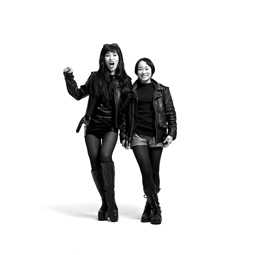 |
|
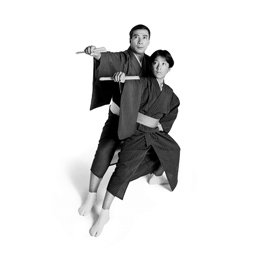 |
| Parent: Sheena / singer; child: Junko Ayukawa / high school student |
|
Parent: Danjuro Ichikawa / kabuki actor; child: Shinnosuke Ichikawa / kabuki actor |
When Tokyo-based commercial photographer and filmmaker Bruce Osborn shot his first oyako (parent and child) combination in 1982, it had started off as a simple assignment for a music magazine. Now, with a remarkable archive of 3,000 parent/child photos spanning three decades, it has become a lifelong project and a fascinating portrait of Japanese society.
"I was photographing a punk band [called Anarchy] and they had their pose and attitude but I wanted to put them in a different situation," said Bruce. "I thought, 'What do the parents of punk musicians look like?'" It was just when Bruce and his wife Yoshiko were expecting their first child and parenthood was very much on his mind. "I thought it would be kind of interesting to see the contrast between the parent and child. But I was surprised to see how close they were and all the similarities."
Bruce's photo of punk musician Shigeru Nakano (donning a distinctive Mohawk) and his mother Yae quickly turned into a series of parent/child portraits that "seemed to take on a life of its own," he says. The work has since become a collaboration between Bruce and Yoshiko, evolving into four books and numerous commercial assignments and exhibitions.
After ten years, the couple wanted to take the series one step further. So in 2003 they launched a "social action to celebrate this special bond" called Oyako Day, held on the fourth Sunday of July. "We agreed that since Mother's Day and Father's Day were on the calendar, there should be a Parent and Child Day too," said Bruce in a published interview.
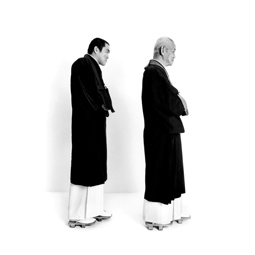 |
|
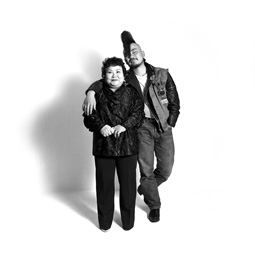 |
| Parent: Taijun Kagenaka / Buddhist monk; child: Akira Kagenaka / Buddhist monk |
|
Parent: Yae Nakano / housewife; child: Shigeru Nakano / musician |
Their latest exhibition -- a selection from this past summer's edition of the event, the Oyako Day Super Photo Session -- will be shown at the Olympus Gallery in Osaka from October 27 to November 2. There is also an extensive exhibition, Irreplaceable Things, until March 31, 2012 at the newly renovated Maibara train station, 21 minutes by bullet train from Kyoto. Here, Bruce and Yoshiko have combined photos from their regular Oyako series with a special four-season, 20-portrait series of families living in the Maibara and Mt. Ibuki area, which is known for its ski resort. The couple persevered through freezing winter weather and piles of snow to bring the series together.
The Oyako subjects have spanned the gamut of Japanese society with some eye-catching and unexpected combinations: tattoo artists and their daughter; mother/daughter tea ceremony instructors; father/son sushi chefs; father/son Buddhist monks; a ramen shop owner and his beautician son; an onnagata (woman's-role) male Kabuki actor and his daughter; a farmer with his policeman son; a rock star mom and her high school daughter (who actually looks more parental).
Bruce has also photographed numerous celebrities and their children, among them actor Ken Uehara and his actor son Yuzo Kayama, and Kabuki family members Danjuro Ichikawa and his son Shinnosuke, 14 at the time. For the past three years their portraits of well-known personalities -- in parent/child combinations -- have appeared as a monthly series in the Mainichi newspaper. Interviews with the subjects accompany the photos.
Bruce photographed some of these pairings several times over the years, offering an intriguing glimpse into change and consistency in his subjects. He photographed popular artist Tadanori Yokoo and his daughter Mimi in 1988 and 1995; while both have aged somewhat in the later portrait, little else seems to have changed. Father Tadanori again looks directly at the camera as if in his own world, showing even more distance from his daughter than he did 13 years before. The Nakano duo -- mother and punk son -- were photographed again in 2003. Shigeru still keeps a fashionable, albeit thinner Mohawk (and his "scary" presence on stage) -- but the affection between the two clearly remains strong.
For their annual Oyako Day Super Photo Session, Bruce and Yoshiko first advertise in a variety of Japanese publications, on the J-Wave FM radio station, and through sponsors. Applicants are asked to write a brief letter explaining why they want to be photographed, and to send a picture of those who will be included. Yoshiko, Bruce and a small committee then field the applications and choose the families based on their diversity and their reasons, the more compelling the better. "This year we got an application from a big family in Miyagi [Prefecture] where the disaster hit. It was the grandfather's birthday," says Yoshiko. "All their photos were destroyed in the tsunami so we really wanted to include them." This year they received about 1,000 applications.
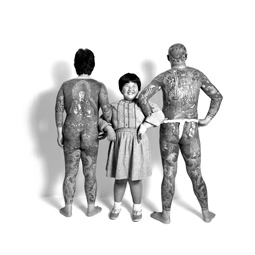 |
|
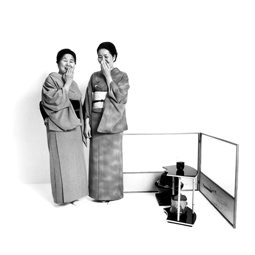 |
| Parents: Mitsuaki Ohwada / tattooist, Akie Ohwada / housewife; child: Keiko Ohwada / elementary school student |
|
Parent: Sogetsu Watanabe / tea ceremony instructor; child: Keiko Mitsui / tea ceremony instructor |
The goal for the one-day marathon is to photograph 100 parent/child pairs. (This year they managed to do 110.) "During the photo sessions we're really pressed for time so we're working on high tension," explains Bruce. "With everyone, I'm trying to get input, either physical or by talking or through suggestions, to get their response. So it's kind of like we're going back and forth. Eventually we find how to communicate with each other and the camera."
Consistency has been the trademark of the series. Everyone is photographed in black and white in a studio setting with a plain white background. Most of the subjects are dressed casually and pose naturally at a set distance from the camera. But getting them into that relaxed pose is no small challenge. Japanese are reserved by nature and many admit they're not used to being photographed with their parent or child. To break the ice, Bruce tries to get them moving. A DJ plays music that he feels will click with the family, and babies and kids are entertained with cute toy animals. A small army of assistants helps the process along. "I try to get them in a situation where they're not concerned about the camera," says Bruce. "The Oyako Day shootings are more like a matsuri (festival) than a sakuhin (artwork)." The ages of their subjects this year ranged from 97 to two weeks old.
Despite the initial awkwardness, the experience is a fulfilling one for most. "I think the photo sessions help the parents and children feel closer," says Yoshiko. "Maybe they haven't had that moment in the past when they could smile and hug each other. It's a very natural thing, even for Japanese. It's a special moment and a special memory for them."
In connection with their Oyako photography, Bruce and Yoshiko oversee several projects including a photo contest and essay contest. They also run Ozone Inc., which offers services that include management, production, coordination, and publishing. Bruce's corporate photography and film work are managed through this company.
Next year, 2012, will be the 30th anniversary of the Osborns' Oyako project. Their work will have spanned an entire generation, capturing the intimate dynamics of the parent/child relationship -- the love, joy, humor, expectations, tensions, and profound bond -- like no other.
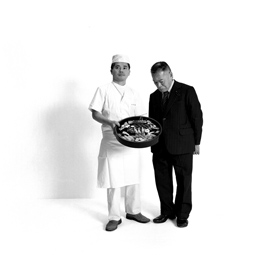 |
|
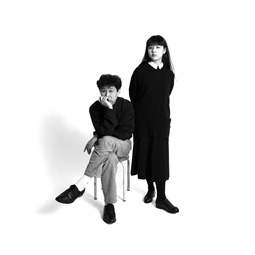 |
Parent: Jisaku Yamada / sushi chef; child: Eiichi Yamada / sushi chef
|
|
Parent: Tadanori Yokoo / artist; child: Mimi Yokoo / artist
All images courtesy of Bruce and Yoshiko Osborn
|
|
 |
 |
Lucy Birmingham
Based in Japan for almost 25 years, Lucy Birmingham has written for Newsweek, Bloomberg News, Architectural Digest, The Boston Globe, Artinfo.com, Artforum.com, and ARTnews, among other publications. As a photojournalist her work has appeared in The New York Times, Business Week, Forbes, Fortune, U.S. News and World Report, and A Day in the Life of Japan. She is also a scriptwriter and contributing editor at NHK, Japan's public broadcaster, and has published several books including Old Kyoto: A Guide to Traditional Shops, Restaurants, and Inns. |
|
 |
|